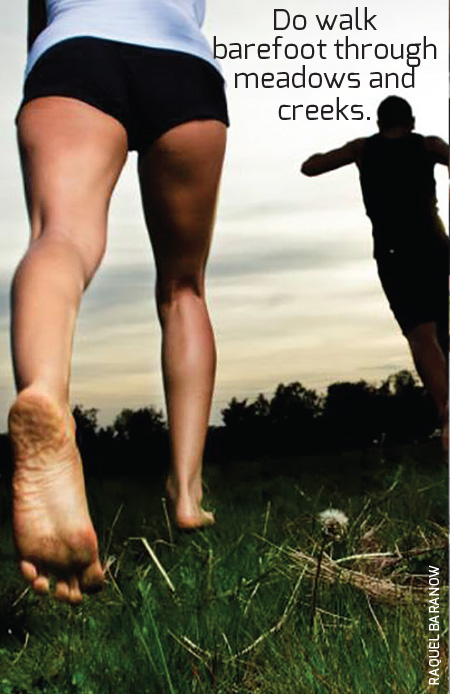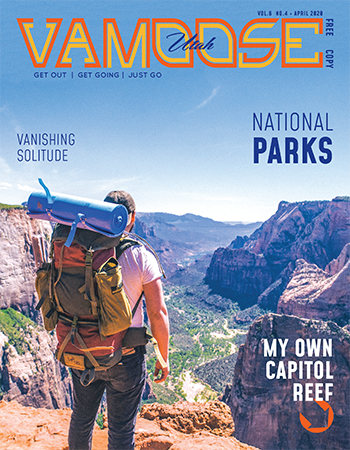Introducing your soles to the Earth might actually promote your well-being.
I’m one of those rare barefoot creatures that’ll frolic past you on the trail. You’re more likely to see people like me running or hiking in hideous Vibram Five Fingers or simple sandals than naked feet. But, even then, to the average hiker, those foot coverings don’t appear to provide enough protection for rocky terrain, either. Why don’t we just wear shoes like normal people?
First, it’s not as crazy as it looks. Natural hazards are easy to avoid when you move at barefoot speed. Partially buried glass, plastic and metal left by people are the biggest dangers. Running barefoot in the Wasatch mountains is pushing it. Small pebbles feel like landmines, and one misplaced step can hurt for a week. Despite the risks, barefoot and minimalist hikers and runners have eliminated one of the biggest threats to the health of their feet, ankles and knees: shoes.
Yes, believe it or not, research has shown that overly padded running shoes can make feet weak, causing runners to overpronate (rotate their ankles). This can potentially cause knee problems. The research comes from Daniel Lieberman, a Harvard University professor of biological anthropology, and his team who are dedicated to studying the biomechanics of foot strikes in endurance running.
A study by Lieberman, along with University of Utah biologist Dennis Bramble, concluded that humans evolved from ape-like ancestors, and that we evolved because of running long distances, ostensibly to hunt. Running, in fact, ultimately shaped our anatomy, making us look like we do today.
 Our ancestors ran long distances after game to weaken their prey. This technique, called “persistence hunting,” included tracking, walking and running as a group until animals become exhausted. The San people in the Kalahari Desert and the Rarámuri people of northwestern Mexico still practice it today. Born to Run, a 2009 best-selling book written by American journalist Christopher McDougall, uses the stories of iconic ultrarunners—Scott Jurek, Jen Shelton and Micah True—and the Rarámuri tribe of Mexico to explore this ritual hunt and a body of research that paints modern running shoes as the main culprit behind the 60-80 percent injury rate suffered by runners every year.
Our ancestors ran long distances after game to weaken their prey. This technique, called “persistence hunting,” included tracking, walking and running as a group until animals become exhausted. The San people in the Kalahari Desert and the Rarámuri people of northwestern Mexico still practice it today. Born to Run, a 2009 best-selling book written by American journalist Christopher McDougall, uses the stories of iconic ultrarunners—Scott Jurek, Jen Shelton and Micah True—and the Rarámuri tribe of Mexico to explore this ritual hunt and a body of research that paints modern running shoes as the main culprit behind the 60-80 percent injury rate suffered by runners every year.
What the book points out is that indigenous long-distance runners don’t wear padded running shoes. Many, like the Rarámuri, wear simple sandals and run ultra marathons as part of their lifestyle—without high injury rates. McDougall goes on to explore research that shows how the biomechanics of the human foot, ankle and knee are optimized to run without heavily padded shoes and why overbuilt shoes cause injury by encouraging us to walk and run incorrectly. You can thank Born to Run for the growing popularity of minimalist shoes such as Vibram Five Fingers, Nike Frees, Merrell Trail Gloves, Altras, Huaraches (running sandals) and shoes with Zero Drop.
The idea that I had been walking and running the wrong way my whole life captivated me. I decided it was time to change the way I moved through the world. This book inspired me to kick off my shoes and never look back.
 Twigs in his hair
Twigs in his hair
My first year of walking on the front of my feet came with chronically sore calf muscles and what felt like a stride from the Ministry of Silly Walks. Once I got the hang of “barefoot walking,” I found my first pair of minimalist running shoes and started running for the first time in seven years. Trail running in Merrell Trail Gloves involved bruised feet and recovery weeks that I wouldn’t have had wearing other shoes. What made the time off from running worth it? The amusing conversations with concerned summer tourists at Park City Resort surely keep me going.
“Are you sure you don’t need help?” asks a concerned hiker.
“Yes, I’m sure, thank you very much,” says the barefoot person with twigs in his hair.
Take it slow
When you change to minimalist shoes or kick off shoes entirely, you need to strengthen the muscles in your feet, ankles and legs in new ways before you can run. And, you have to build up a tolerance to simply walking across the ground because your feet have more sensory nerves per square inch than anywhere else in your body.
I also couldn’t run nearly as far or as fast as my friends in running shoes, but I loved the meditation of the practice. Any time I thought about anything that wasn’t the trail in front of me, I’d pay for it. Nothing less than full absorption was acceptable.
Since then, I’ve run hundreds of miles (many more in minimalist footwear than barefoot) and never sustained a serious injury. The only laceration on my foot came from an electrical socket cover on the floor of a house after an accident-free 4-mile trail run in sandals. Giving myself time to adapt to a new way of walking and running is the only reason I didn’t end up breaking my feet.
 Baring your sole has risks
Baring your sole has risks
Barefoot running, while potentially beneficial for your ankles and knees, isn’t without risk. Any podiatrist will tell you that running without shoes is dangerous no matter how seasoned your feet are. As someone who does it, I don’t disagree.
“I don’t care how strong and thick your skin becomes, it will never keep a needle, nail, glass shard or thorn out with your full weight slamming down on it. If you do elect to go with the minimalist shoes, you will be best served by training with an experienced ‘barefoot’ runner or trainer,” says local podiatrist Dan Preece.
He’s right. I have thick skin that holds up to casual contact with cactus spines, but a piece of glass under the foot would be devastating.
If you want to go barefoot, keep these tips in mind: Don’t start running until you change the way you walk. Ease into it. Don’t walk barefoot on the most popular trails or camping areas because there may be dragons. Do walk barefoot through meadows and creeks after it rains. Most importantly, know that once you lose your shoes, it’s hard to put them back on.
Ultimately, I hike and run barefoot for the experience of being fully connected with the terrain. Walking through a loamy pine forest, hiking to Sunset Peak, or squishing through a muddy meadow after a spring rain are some of the most sensual experiences you can have. You have to move with the shape of the earth and every place and season has its own beautiful rhythm.
Now, I wear my sandals everywhere and take them off whenever I can. The thought of stuffing my feet into socks and shoes makes me want to run away into the woods. I do so in the winter because I have no other choice, but I’ve worn my sandals when there’s snow on the ground plenty of times. Most dress codes will never work for me, and there are many jobs I can’t apply for. Thankfully, my business and freelance lifestyle support me, and there are plenty of the people in the world who aren’t scared of feet.



